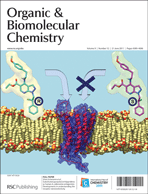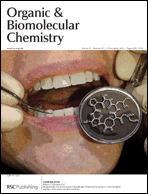The OBC Editorial team has collected the most cited Perspectives published in our journal in the last 5 years and you can now download them for free!
Perspective articles are either a concise and critical appraisal, or a personal viewpoint of activity in a specialist area of organic chemistry of current interest, and are not intended to be comprehensive reviews of the literature. They are normally published by invitation of the Editorial team but suggestions from authors are welcome and enquiries should be directed to the Editor.
Find the top 5 most cited Perspectives in the last 5 years below. Our congratulations and thanks to the authors!
Recognition and activation by ureas and thioureas: stereoselective reactions using ureas and thioureas as hydrogen-bonding donors
Yoshiji Takemoto
Org. Biomol. Chem., 2005, 3, 4299-4306
DOI: 10.1039/B511216H
DNA-programmed assembly of nanostructures
Kurt V. Gothelf and Thomas H. LaBean
Org. Biomol. Chem., 2005, 3, 4023-4037
DOI: 10.1039/B510551J
Bifunctional transition metal-based molecular catalysts for asymmetric syntheses
Takao Ikariya, Kunihiko Murata and Ryoji Noyori
Org. Biomol. Chem., 2006, 4, 393-406
DOI: 10.1039/B513564H
Analysis of the reactions used for the preparation of drug candidate molecules
John S. Carey, David Laffan, Colin Thomson and Mike T. Williams
Org. Biomol. Chem., 2006, 4, 2337-2347
DOI: 10.1039/B602413K
Density functional theory with dispersion corrections for supramolecular structures, aggregates, and complexes of (bio)organic molecules
Stefan Grimme, Jens Antony, Tobias Schwabe and Christian Mück-Lichtenfeld
Org. Biomol. Chem., 2007, 5, 741-758
DOI: 10.1039/B615319B











 On our cover this issue is work from Silvia Schenone (University of Genoa, Italy) describing the separation of enantiomers of newly-synthesised A1 adenosine antagonists. The group had previously synthesised a family of pyrazolo[3,4-b]pyridine derivatives, and here show that the enantiomers of the most active compound have different affinity for the receptor.
On our cover this issue is work from Silvia Schenone (University of Genoa, Italy) describing the separation of enantiomers of newly-synthesised A1 adenosine antagonists. The group had previously synthesised a family of pyrazolo[3,4-b]pyridine derivatives, and here show that the enantiomers of the most active compound have different affinity for the receptor.
 The very successful OBC Communication by Robert H. Cichewicz and coworkers, at the University of Oklahoma, on mutanobactin A and its influence on the yeast-mycelium transition of Candida albicans is now the inside cover of Issue 24.
The very successful OBC Communication by Robert H. Cichewicz and coworkers, at the University of Oklahoma, on mutanobactin A and its influence on the yeast-mycelium transition of Candida albicans is now the inside cover of Issue 24.